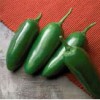 Pepper is an important vegetable crop in Miami-Dade County. Unlike other vegetable crops, peppers are relatively more adaptable to the environment, especially the heat, and are relatively easier to grow. But to be successful, careful attention must be paid to maintain healthy plants and high productivity with efficient management of soil and water for the particular needs of each variety or cultivar. This 7-page fact sheet provides general information and guidelines for pepper growers in Miami-Dade County, including major pepper varieties, and their horticultural traits, and fundamental soil and water management requirements. Written by Qingren Wang, Shouan Zhang, Yuncong Li, Dakshina Seal, Waldemar Klassen, and Teresa Olczyk, and published by the UF Department of Horticultural Sciences, February 2015.
Pepper is an important vegetable crop in Miami-Dade County. Unlike other vegetable crops, peppers are relatively more adaptable to the environment, especially the heat, and are relatively easier to grow. But to be successful, careful attention must be paid to maintain healthy plants and high productivity with efficient management of soil and water for the particular needs of each variety or cultivar. This 7-page fact sheet provides general information and guidelines for pepper growers in Miami-Dade County, including major pepper varieties, and their horticultural traits, and fundamental soil and water management requirements. Written by Qingren Wang, Shouan Zhang, Yuncong Li, Dakshina Seal, Waldemar Klassen, and Teresa Olczyk, and published by the UF Department of Horticultural Sciences, February 2015.
http://edis.ifas.ufl.edu/tr010
Tag: non-bell pepper
Jalapeño and Other Hot Pepper Varieties for Florida

The jalapeño is derived from the Capsicum genus of the family Solanaceae. Jalapeños are members of a diverse group, which also include ancho poblano, cayenne, serrano, Anaheim, banana, Asian, habanero, and Hungarian wax peppers. Hot peppers are classified by their heat and shape. The heat of the pepper comes from the chemical compound capsaicin, which is measured by the Scoville scale. This 8-page fact sheet is a guide of jalapeño and other hot pepper varieties used in Florida was written by Monica Ozores-Hampton and Gene McAvoy, and published by the UF Department of Horticultural Sciences, October 2014.
http://edis.ifas.ufl.edu/hs1241
Heirloom Hot Pepper Varieties for Florida
 Here is a guide of the popular pepper varieties used in Florida. The popularity was assessed from a survey among seed suppliers, which include Baker Creek Heirloom Seeds, Burpee, High Mowing Seeds, Southern Exposure Seed Exchange, Tomato Grower Supply Company, Seeds of Change, Territorial Seed Company, and My Patriot Supply. When organic seeds were available, the USDA logo was inserted. The relative Scoville rating, which measures a pepper’s pungency, was also included when it was available. This 15-page fact sheet was written by Monica Ozores-Hampton, and published by the UF Department of Horticultural Sciences, November 2014.
Here is a guide of the popular pepper varieties used in Florida. The popularity was assessed from a survey among seed suppliers, which include Baker Creek Heirloom Seeds, Burpee, High Mowing Seeds, Southern Exposure Seed Exchange, Tomato Grower Supply Company, Seeds of Change, Territorial Seed Company, and My Patriot Supply. When organic seeds were available, the USDA logo was inserted. The relative Scoville rating, which measures a pepper’s pungency, was also included when it was available. This 15-page fact sheet was written by Monica Ozores-Hampton, and published by the UF Department of Horticultural Sciences, November 2014.
http://edis.ifas.ufl.edu/hs1244